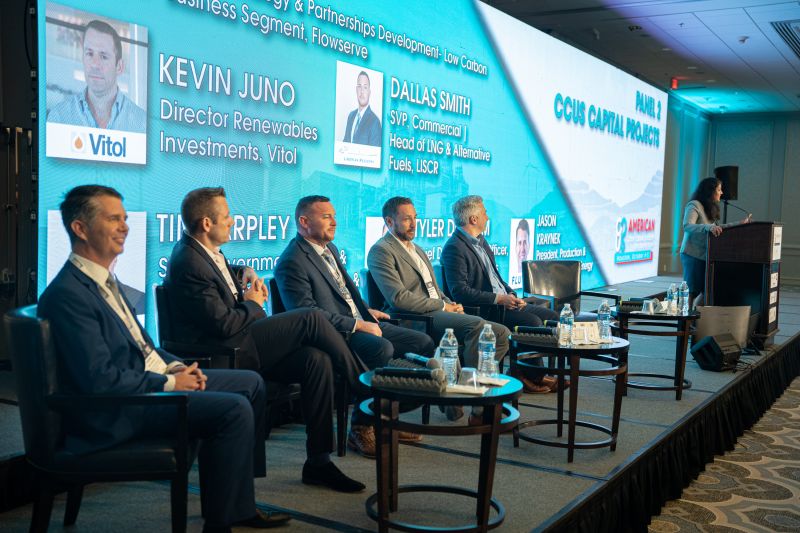Recap of American CCUS Forum, Part 1
Inside this issue
American CCUS Forum Recap
Last week, the American CCUS Forum took place in Houston, Texas. It was a fantastic opportunity to visit with leaders across the carbon management value chain.
Read the take-aways from the event:
- Funding opportunities with DOE & creative investors
- Regulatory primacy & permitting process
- Supply chain bottlenecks
- Staffing challenges
- Public perception
💰 Funding Opportunities from Department of Energy
The DOE is transforming to enable more grants, more loans, and more deployment for clean energy. Carbon sequestration is a critical element of the DOE's Fossil Energy & Carbon Management loan program.
In August, the DOE announced $31 million in capital for FEED and lab studies for industrial decarbonization. A couple weeks later the DOE announced plans to fund $4.9 billion in carbon management projects.
Since January 2021, DOE has invested more than $242 million in 55 research and development projects and front-end engineering design studies to advance carbon management approaches that include CO2 capture, transport, and storage. Source: DOE
In the first presentation, Matt Kittel explained three options available to companies building and deploying carbon capture management and storage facilities.
Financial Assistance from Office of Fossil Energy and Carbon Management (FECM). There are grants available for eligible CCUS projects through the Bipartisan Infrastructure Law (BIL). This BIL funding opportunity will provide funding for up to twenty (20) Front End Engineering Design (FEED) studies for integrated Carbon Capture and Storage (CCS) and is open now at the Office of Clean Energy Demonstrations funding website.
Hubs from FECM & Office of Clean Energy Demonstrations (OCED). Not surprisingly, regional hubs were mentioned throughout the conference. The definition and commercial terms of most regional hubs are still developing; however, not all components need to be present within a given hydrogen ecosystem. These hydrogen ecosystems need to have one
or more clean energy resources like solar, wind, nuclear, or fossil sources with CCS to produce clean hydrogen that is stored and delivered for the region. Read more about the hub funding announcement here.Loans from Loan Programs Office (LPO). Within the DOE, the Loan Programs Office is underwriting CCS projects through Title XVII - Section 1703 and 1706. The technology does not need to be innovative and these processes are similar to commercial credit application. In addition, the Carbon Dioxide Transportation Infrastructure and Innovation (CIFIA) Program will be announced soon for CO2 transportation projects.
Over $300 billion in funding possible from these DOE sources.
💡 Getting Creative with Investors
Day 1 ended with a panel on CCUS capital projects with Energy Workforce & Technology Council, Vitol, Flour, Liberian Registry, and Navigator CO2. The cross-section of panel members made for an interesting discussion around financing projects today and what the next year could hold.

45Q for CCS and CCS+EOR has made members of the Energy Workforce & Technology Council bullish on opportunities for carbon capture. With the passing of IRA, more projects are "in the green" and make economic sense to execute. Numerous companies in the energy industry are already familiar with 45Q and others are now taking note of the tax credit opportunity.
Even with Oxy's Permian DAC 1 facility recent construction announcement, there was little discussion around 45Q for DAC and DAC+EOR. A substantial increase to $180 per ton was mentioned briefly but the panel did not mention funding or project increases for in DAC projects.
Different types of investors are looking at carbon management deals. Several panel members commented on creative financing to get projects executed. A diverse range of commercial credit, tax equity, and equity structures could help get more carbon sequestration projects reach the execution phase. There are too many projects stalled early in the project development process due to commercial terms. Furthermore, some investors may see the term limits of 45Q as a risk to the project where as others are expecting 45Q terms to continue, just at a lower per ton tax credit.
Upstream, midstream, and downstream operations are vital to carbon sequestration project success. The panel encouraged new project developers to create unique deal structures that help meet the carbon value chain goals. Not all CO2 source facilities are ready to capture and transport CO2. Size, quality, and readiness to capture the CO2 are factors that will influence the commercial terms, costs, and size of a project. Reducing these costs and scaling carbon capture are needed now, even though the industry is in early stages.
The panel did not expect CCS projects to benefit from the voluntary carbon markets. The voluntary carbon markets are growing but will likely be unavailable since only one of the registries offers carbon credits for EOR and most of the companies will use CO2 sequestration to offset their company's Scope 1 emissions.
With an increase in 45Q, creative commercial terms together with a strong understanding of tax credits will help more projects be financed. It will be critical to work with creative investors on deal structures that allow flexibility while aligning the incentives of the parties.
Inside this Issue
🔥 Fervo Energy to Provide 24/7 Carbon-Free Geothermal Electricity to Clean Power Alliance’s Three Million Southern California Customers
🚨 Syzygy Launches CarbonModel.com, an Online Tool for Calculating Carbon Footprint and Levelized Cost of Hydrogen Production
🔋 HyAxiom Signs Agreement with Shell To Demonstrate Fuel Cell Technology's Ability to Decarbonize Shipping Industry
🏭 Chemours Announces Joint Venture Agreement with BWT to Enable the Capacity and Innovation Required by the Transportation Fuel Cell Market
⚙️ H2 Green Steel partners with Midrex for technology and Kobe Steel for equity investment
🛩 Delta, Joby Aviation Partner to Pioneer Home-to-Airport Transportation to Customers
Articles in this issue